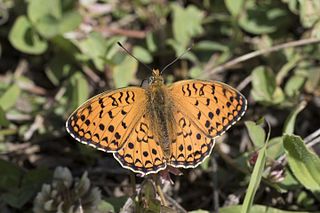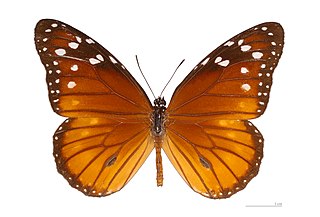
The Adonis blue is a butterfly in the family Lycaenidae. It inhabits the Palearctic realm.

The Niobe fritillary is a species of butterfly in the family Nymphalidae.

The great spangled fritillary is a North American butterfly of the family Nymphalidae.

Papilio clytia, the common mime, is a swallowtail butterfly found in south and southeast Asia. The butterfly belongs to the subgenus Chilasa, the black-bodied swallowtails. It serves as an excellent example of a Batesian mimic among the Indian butterflies.

Kaniska canace, the blue admiral, is a nymphalid butterfly, the only species of the genus Kaniska. It is found in south and southeast Asia.

The Indian fritillary is a species of butterfly of the nymphalid or brush-footed family. It is usually found from south and southeast Asia to Australia.

Melitaea didyma, the spotted fritillary or red-band fritillary, is a butterfly of the family Nymphalidae.

Boloria bellona, the meadow fritillary, is a North American butterfly in the brushfoot family, Nymphalidae. The common name, meadow fritillary, is also used for a European butterfly species, Melitaea parthenoides.

Nathalis iole, the dainty sulphur or dwarf yellow, is a North American butterfly in the family Pieridae.

Euptoieta claudia, the variegated fritillary, is a North and South American butterfly in the family Nymphalidae. Even though the variegated fritillary has some very different characteristics from the Speyeria fritillaries, it is still closely related to them. Some of the differences are: variegated fritillaries have two or three broods per year vs. one per year in Speyeria; they are nomadic vs. sedentary; and they use a wide range of host plants vs. just violets. And because of their use of passionflowers as a host plant, variegated fritillaries also have taxonomic links to the heliconians. Their flight is low and swift, but even when resting or nectaring, this species is extremely difficult to approach, and, because of this, its genus name was taken from the Greek word euptoietos meaning "easily scared".

Parides alopius, the white-dotted cattleheart, is an endemic Mexican butterfly in the family Papilionidae. It has also strayed once into the United States in southeastern Arizona.

Autochton cellus, the golden banded-skipper, is a North and Central American butterfly in the family Hesperiidae. There are two populations, one in the eastern United States and the other in the southwestern United States and Mexico. The eastern population is rare and local and uses only one host plant, the thicket bean. The southwestern population is uncommon to common and uses more than one host plant. The golden banded-skipper is most active mid-morning and late afternoon. Their flight is sluggish and low to the ground, compared to closely related species.

Danaus eresimus, the soldier or tropical queen, is a North American, Caribbean, and South American butterfly in the family Nymphalidae.

Eurema mexicana, the Mexican yellow, sometimes called the wolf-face sulphur, is a North and South American butterfly in the family Pieridae. It occurs mainly in Mexico but occasionally is found in central and southwestern United States and rarely in Canada.

Eurema proterpia, the tailed orange, is a North and South American butterfly in the family Pieridae.

Chlosyne lacinia, the bordered patch or sunflower patch, is a North and South American butterfly in the family Nymphalidae.

Papilio palamedes, the Palamedes swallowtail or laurel swallowtail, is a North American butterfly in the family Papilionidae.

Kricogonia lyside, the lyside sulphur or guayacan sulphur, is a North American, Caribbean, and South American butterfly in the family Pieridae.

Chlorostrymon simaethis, the silver-banded hairstreak, is a North and South American butterfly in the family Lycaenidae. It is also known as St. Christopher's hairstreak and the Key lime hairstreak.

Speyeria callippe, the callippe fritillary, is a North American species of butterflies in the brush-footed family Nymphalidae.




















